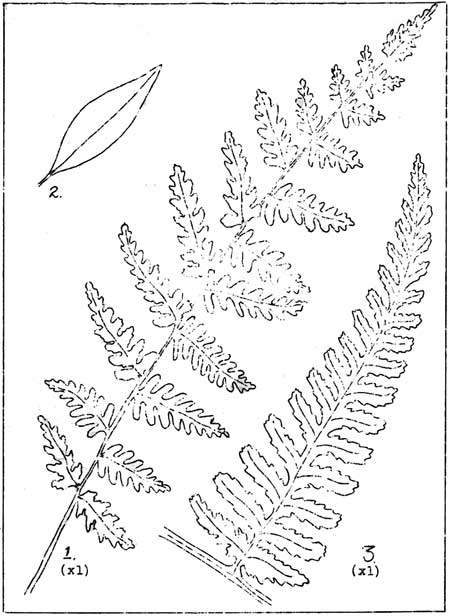 |
|
Male Fern
(Dryopteris filix-mas). 1. Frond. 2. Diagramatic sketch
illustrating characteristic oblong-lanceolate outline of the frond. 3.
Pinna illustrating serrate edges of segments.
|
MALE FERN
(Dryopteris filix-mas (L.)
Schott.)
This plant is not especially common in Mount Rainier National Park.
Locally its characteristic habitat is in moist woods. Although
its altitudinal range has not, as yet, been definitely determined for
the park area it may be assumed that one will encounter it throughout
the timbered zones of this area. Botanically its range is almost
world wide. It is found from Alaska to California and East to the
Atlantic, in Mexico, Greenland, Europe, Africa and South America.
The fronds are herbaceous, tufted, deep green and firm in
texture. They are from 12-48 inches long, 4-12 inches wide,
oblong-lanceolate in outline and once compound. The larger
pinnae possess short stalks and their segments are serrate,
particularly at the apex, with oblique teeth. The leafstalk is
rather stout, about 1/4 the length of the frond, scaly and green to
brown in color.
The name is from the latin (Frye) "filix" - Fern, and "mas" - man.
The term was used by early botanist in distinguishing it from one of its
associates, the Lady Fern (Athyrium filix-femina).
SYNONYMS: Aspidium filix-mas Sw.; Nephrodium filix-mas Rich.;
Polypodium filix-mas L.; Lastrea filix-mas Presl.; Thelypteris filix-mas
Nieuwl.
-oOo-
BRITTLE FERN.
(Cyrstopteris fragilis
(L.) Bernh.)
The slender, fragile leafstalks account for the common name of this
fern which, though it is not common in the park, is often encountered in
the upper Canadian and lower Hudsonian regions. It does not show any
marked preference in habitat except that it is most generally
found growing about boulders or angular rocks in the soil and
occasionally in talus slopes. The soil is generally fairly moist and
well drained where this plant is found. Botanically, its range
is very wide, the Brittle Fern being one of the most widely distributed
ferns in the entire world. It occurs throughout the northern hemisphere
and in North America its range is bounded by Alaska and Greenland on the
north and on the south by California, Arizona, New Mexico, Alabama and
Georgia. Locally it occurs from 2500' to 6000'.
The Brittle Fern has a fragile or delicate appearance. Its fronds
rise in a loose spreading tuft, each frond describing a graceful arch.
The fronds are from 4-16 inches long, ovate-lanceolate in general
outline being from 1-3 inches wide with the widest portion at the base.
Fronds are 1-2 compound. The pinnae are short stalked,
ovate-lanceolate in outline and widest at the base with rounded teeth on
the margin of the pinnules. The spores are borne in sori that
are round and, though small, are conspicuous on the under side of the
pinnules. The leafstalk is slender, fragile and brittle, nearly
as long as is the foliate portion of the frond and straw colored.
SYNONYMS: Polyodium fragile L.; Filix fragilis Gilib.;
Aspidium tenue Sw.
-oOo-
GRAPE FERN.
(Botrychium Spp.)
These plants are comparatively rare in Mount Rainier National Park
and are seldom found unless a specific search is made for them. Their
small size and the manner in which associated vegetation tends to
obscure them from view enhances their rarity. Locally the Grape Ferns -
of which there are three species listed as native to the park area - are
found in deep moist to swampy woods. While the tree species vary in
appearance they all have the characteristic grape-like buncdh of
sporangia, which is borne upon a leafless branch and which arises from
some point on the slender stalk. This character accounts for the common
name. The foliar portion of the plant bears leaves that are one to
three compound which are, in turn, divided into numerous segments.
In the field key (see page 12) a distinction is made between the
three species indigneous to Mount Rainier National Park.
-oOo-

